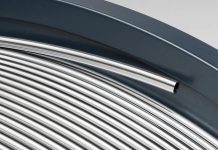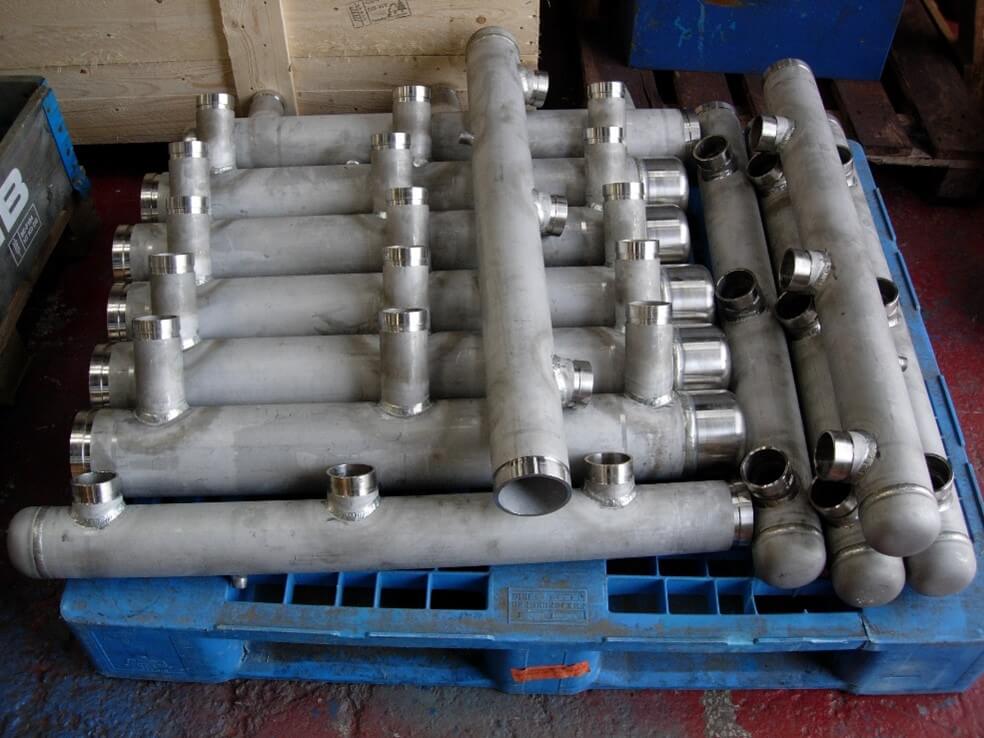
Biogas plants make a valuable contribution to green energy generation: they provide electricity, heat, gas and vehicle fuel, thereby significantly reducing greenhouse gas emissions. Additionally, these plants contribute to the reduction of organic waste. Due to their exceptional corrosion resistance and strength, molybdenum-containing stainless steels have been proven to be an excellent choice for various biogas production applications.
By Martina Helzel, circa drei
Biogas production has huge potential across the globe, as a wide variety of organic materials can be used to produce green energy. The range of feedstock is diverse and includes biomass-containing residual waste such as sewage sludge, biowaste from households and production processes, and food waste. Liquid manure and dung derived from livestock farming, as well as previously unused plants or plant parts, can also be effectively utilized, avoiding the waste of valuable resources. In some countries, specifically cultivated energy crops like corn are grown as renewable raw materials for biogas production.
Biogas production
The anaerobic digester or fermenter is the core of the biogas plant. In its oxygen-free environment, various microorganisms, primarily bacteria, break down the organic material in multiple stages resulting in the production of biogas. Most forms of feedstock must be pretreated to enhance digestibility. Some are shredded or ground into smaller parts, depending on the material. The pH value of the biomass, usually between 6.5 to 8, also affects gas production. The system can be self-heated by the exothermic digestion process, though usually additional heat is provided by burning some of the biogas. Most systems have an operating temperature between 25° and 45°C. Higher temperatures between 50° and 60°C are possible to produce gas more quickly. Biogas comprises about 60% methane and 35% carbon dioxide, as well as small amounts of other gases. Methane and carbon dioxide are both greenhouse gases that contribute to environmental damage. However, the process of anerobic digestion captures these gases that would otherwise be emitted directly into the atmosphere from the decomposition of organic matter. Since the greenhouse gas potential of methane is many times higher than that of carbon dioxide, capturing methane and burning it to produce carbon dioxide is much better for the environment.
The biogas generated in the digester is collected through a network of pipes and transferred to a gas storage system, where it remains until it is ready for use or further processing. Biogas serves various purposes: it can be directly used as heating or cooking fuel or channeled into a combined heat and power (CHP) generator to produce heat and electricity. This flexibility makes biogas a valuable local energy source, suitable for households, farms, communities, and industries. Biogas or generated electricity can also be fed into the grid to contribute to the broader energy supply. Additionally, biogas can be further processed, resulting in a higher-quality fuel suitable for converted road vehicles. This upgraded biogas, known as renewable natural gas (RNG) or biomethane, has a similar quality as fossil-based natural gas, typically containing 90% or more methane.
The material left over after digestion, called digestate, accounts for around 50% of the input mass. Digestate is a valuable fertilizer that significantly reduces greenhouse gas and odor emissions compared to unprocessed manure fertilizer. Rich in nutrients, digestate can be applied as a liquid or a solid, thus diminishing reliance on costly and potentially harmful chemical fertilizers.

Better than concrete
Concrete, and to a lesser extent, carbon steel are currently the most common digester tank materials, mainly because of their lower initial cost. However, concrete tank construction must be relatively large scale to be cost effective, requires heavy machinery, is labor intensive and takes a long time to cure. Regular maintenance is crucial to prevent leakages in a digester. Leaking gas, water and odor can cause serious problems for the plant and its surrounding areas. Nevertheless, corrosion is difficult to avoid in concrete and carbon steel digester tanks, even when a special coating system is utilized. Stainless steel tanks, on the other hand, can be quickly installed without the need for heavy machinery, scaffolding or cranage. Typically circular in shape, with diameters up to 35 m, these tanks are assembled on-site by bolting segments of stainless steel sheet together. The tanks are built up ring by ring, starting with the top ring. The partially built tank is then lifted with simple jacks to make space for assembly of the next ring, until the desired height is reached. Prefabrication and construction allow for a precise fit and individual design of the tanks. Due to the segmental design of the tanks, vertical extensions can easily be added at a later stage. Even after years of use, the tanks can be dismantled and reconstructed at a different location. At the end of its long life, stainless steel can be sold as valuable scrap which is 100% recyclable.

Japan is the most earthquake-prone country on earth. While it remains heavily dependent on fossil fuels, renewable energy already accounts for one-fifth of total energy production. Stainless steel biogas tanks are resilient and can easily be customized to meet earthquake-resistance requirements as well as local wind load specifications. This new plant in Saitama near Tokyo converts 12,000 tonnes of organic waste, including cattle manure from a nearby farm, into energy each year. Three stainless steel tanks for upstream feedstock storage, digestion and digestate storage ensure an efficient and durable production process of the biogas plant.
Avoiding corrosion

Corrosive compounds, such as organic acids, hydrogen sulfide or chlorides are unavoidable byproducts of the biogas production process. The type and concentration of these byproducts depend on the composition of the feedstock and the operating conditions inside the digester. Unprocessed plant-based feedstock generally results in the least corrosive byproducts. However, if the feedstock contains residues from meat or fish processing, higher levels of sulfur compounds may be produced. Similarly, if the feedstock includes convenience food or food scraps, sodium chlorides may be present, contributing to the corrosivity. The desulfurization of biogas, which is necessary before feeding it into a CHP generator, can also produce highly corrosive byproducts.
Managing the corrosive compounds in biogas production is crucial to prevent damage to the equipment. Repairing and restarting a digester is a complex and time-consuming process, so using materials that resist corrosion in the first place is key. Fortunately, there is a wide range of stainless steel grades available that allows for cost-effective material choices. By selecting an appropriate corrosion resistant grade, it is possible to mitigate the negative effects of corrosive compounds. This ensures trouble-free operation throughout the lifespan of digestion and storage tanks, as well as other components like pumps, valves, agitators, pipes, fittings, and purification equipment.
A digester tank for example, can be divided into two zones, the lower part which is filled with liquid and solid biomass and the gaseous zone above. The splash or tidal zone at the interface is particularly susceptible to corrosion, as corrosive substances can concentrate on the tank walls during wetting and drying cycles. To address this, it is common to use a more highly alloyed grade such as 2205 duplex stainless steel, for the upper part. For the permanently submerged bottom part a lower alloyed stainless steel can be used, such as 2101 duplex. These molybdenum-containing stainless steels provide sufficient corrosion resistance and durability for each particular environment. Using duplex stainless steels instead of standard austenitic grades, like Type 304 or 316 stainless steel, offers another advantage. In some cases, the high strength of duplex stainless steels will enable the wall of the tank to be reduced, resulting in weight savings, which makes them a cost-effective alternative.

Near Belfast, Northern Ireland, a food logistics company implemented an innovative approach to fuel its trucking fleet with food waste from the grocery stores it serves. A total of 17,500 tonnes of organic material sourced from over 40 supermarkets is converted to RNG on an annual basis. The food leftovers undergo a process of pasteurization, shredding and homogenization, followed by anaerobic digestion in two stainless steel digesters with a capacity of 2,625 cubic meters each. To use it as a truck fuel, 450 cubic meters of biogas are upgraded into RNG every hour. The company’s fleet of trucks, which run on this biofuel, emit an impressive 93% fewer carbon emissions compared to traditional diesel trucks.

The coastal region around Turku in southwestern Finland is characterized by its livestock farms. In this area, a 250 kW biogas plant makes use of around 40,000 tonnes of pig manure every year as its sole feedstock. The generated heat powers the 4,903 cubic meter stainless steel digester and also provides heat to nearby hog fattening houses. The entire operation of the biogas plant is fully automated, finishing with the separation of the digestate. Compression of the digestate makes it easier to transport, allowing excess fertilizer to be moved to regions where it is needed. Most importantly, by processing the manure, the plant actively combats the accumulation of nutrients in the already vulnerable local waterways and the Baltic Sea.
The big picture
Biogas plants easily adapt to shifts in power demand. As the share of renewable energy sources continues to grow, the flexibility of biogas in covering peak demands and balancing the intermittent periods of other renewables such as wind and solar power becomes increasingly important. Every part of the world has the potential to produce biogas or biomethane. With the development of local collection logistics and supply chains, the availability of sustainable feedstocks for these purposes is set to grow by 40% by 2040, according to the International Energy Agency (IEA) report, “The Outlook for Biogas and Biomethane” (2020).
Most of the biomethane resources examined in the IEA report are currently more expensive to produce than the prevailing natural gas prices in their region, but the cost gap is projected to narrow over time. Recognizing the value of avoiding carbon dioxide and methane emissions goes a long way towards improving the cost-competitiveness of biomethane. Overall, biogas production costs are projected to decrease slightly while natural gas prices tend to rise. The invasion of Ukraine tends to put upward pressure on the price of natural gas. Coupled with the potential environmental benefits of biogas production in reducing emissions from organic waste, there is a stronger incentive than ever to increase biogas production.
About IMOA
Reproduced with the kind permission of the International Molybdenum Association (IMOA). IMOA is a non-profit trade association representing the majority of the molybdenum industry worldwide. For information, visit www.imoa.info
The Könnern industrial park near Magdeburg, Germany hosts one of the world’s largest biogas refineries, which began operating in 2009. This impressive plant processes about 120,000 tonnes of raw materials and liquid manure each year, supplied by around 30 local farmers. According to the operator WELTEC BIOPOWER, the plant annually produces 15 million cubic meters of biomethane, enough to power around 10,000 households or provide 9,000 cars with an annual mileage of 30,000 kilometers. The plant contains over 1,500 tonnes of stainless steel in its storage tanks, pumps, and other systems.

About this Tech Article
This tech article appeared in Stainless Steel World, December 2023 magazine. To read many more articles like these on an (almost) monthly basis, subscribe to our magazine (available in print and digital format) – SUBSCRIPTIONS TO OUR DIGITAL VERSION ARE NOW FREE.
Every week we share a new Featured Story with our Stainless Steel community. Join us and let’s share your Featured Story on Stainless Steel World online and in print.








